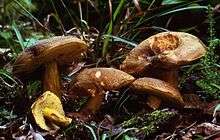Boletus porosporus
Xerocomellus porosporus is a small wild mushroom in the family Boletaceae. These mushrooms have tubes and pores instead of gills beneath their caps. It is commonly known as the sepia bolete.[1]
| Boletus porosporus | |
|---|---|
 | |
| Scientific classification | |
| Kingdom: | |
| Division: | |
| Class: | |
| Order: | |
| Family: | |
| Genus: | |
| Species: | X. porosporus |
| Binomial name | |
| Xerocomellus porosporus (Imler ex Watling) Šutara (2008) | |
| Synonyms | |
|
Imler ex Watling (1968) | |
| Xerocomellus porosporus | |
|---|---|
float | |
| pores on hymenium | |
| cap is convex | |
| stipe is bare | |
| spore print is olive-brown | |
| edibility: edible | |
Taxonomy
This bolete was described and given the scientific name Xerocomus porosporus in 1958 by Louis Imler (1900 - 1993), who was the founder of the Antwerp Mycological Circle. The currently-accepted scientific name Xerocomellus porosporus dates from a 2008 publication by Czech mycologist Josef Å utara, whose studied in detail morphological character of this and other closely-related boletes - since further supported by DNA studies.
Synonyms of Xerocomellus porosporus include Xerocomus porosporus Imler and Boletus porosporus Imler ex G. Moreno and Bon.
Description
When fully expanded, the caps are up to 8 centimetres (3.1 in) in diameter, and are soon cracked or fissured. Varying in colour from putty beige to dull brown,[2] or olivaceous.[3] The stem is usually with very little red, and is olivaceous, more yellow at the apex, and bruises brown. The flesh is pale lemon yellow or buff in the cap, and chrome yellow in the stem apex. It darkens to dark brick or vinaceous towards the base. The tubes are 13 to 20 centimetres (5.1 to 7.9 in) long, initially lemon yellow, later olivaceous, and they bruise bluish. The pores are narrow, 0.2–0.5 mm in diameter, angular, lemon yellow, and darken later.[4] They also bruise blue. The spores give an olive-brown spore print.[5] At microscopic level this bolete has truncate (chopped off) spores;[6] the spore dimensions are 13–15 by 4–5 µm.[7]
Distribution and habitat
X. porosporus appears occasionally in the autumn, and grows singly or in small groups in mixed deciduous woods, particularly with oak, hornbeams, and beech. This species is widespread in northern temperate zones, but somewhat rare in Europe.[4][5]
Edibility
X. porosporus is edible but of little culinary value, being bland, and mushy when cooked.
See also
References
- "Rogers Mushrooms | Mushroom Pictures & Mushroom Reference". Archived from the original on 2011-01-01. Retrieved 2009-03-23.
- Courtecuisse R, Duhem B (1995). Mushrooms and Toadstools of Britain and Europe (British version). Harper Collins. ISBN 0-00-220025-2.
- Bon M (1987). The Mushrooms and Toadstools of Britain and North Western Europe. Hodder and Stoughton. ISBN 0-340-39935-X.
- Peintner U, Ladurner H, Simonini G (2003). "Xerocomus cisalpinus sp. nov., and the delimitation of species in theX. chrysenteron complex based on morphology and rDNA-LSU sequences". Mycological Research. 107 (Pt 6): 659–79. doi:10.1017/S0953756203007901. PMID 12951793.
- Phillips R (2006). Mushrooms. Pan MacMillan. ISBN 0-330-44237-6.
- Arora D (1986). Mushrooms Demystified. Ten Speed Press. ISBN 0-89815-169-4.
- Ellis JB, Ellis MB (1990). Fungi without Gills (Hymenomycetes and Gasteromycetes): an Identification Handbook. London: Chapman and Hall. p. 45. ISBN 0-412-36970-2.